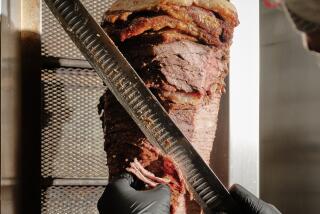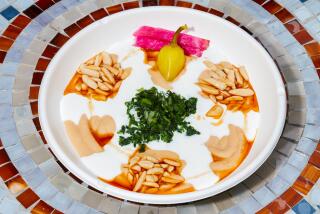Rare Language Survives : Syrian Village Speaks Tongue Used by Jesus
MALULA, Syria — Sheltered in the embrace of beige and mauve sandstone cliffs, the tiny village of Malula has been overlooked by history.
The boxy little houses, which resemble adobe huts with their irregular windows and irreverently crooked chimneys, tumble down the mountainside in a profusion of ramshackle architecture, seeming more fragile than enduring.
Yet some of the buildings here are indeed ancient. The monastery of St. Sergius perched above the village contains what is said to be the oldest Christian altar still in use. The altar stone is so venerable that pagans, who used it before the Christian era, put a lip around the edge so that blood would not spill during their sacrifices.
Village’s Real Treasure
But the real treasure of Malula is not evident in the monastery, in the unremarkable Byzantine chapel, or in any of the half-dozen or so Greek Orthodox and Greek Catholic churches that dot the hillsides, their simple crosses glinting in the sun.
Malula’s treasure is not seen, but heard. Taken unaware, the townspeople of Malula can be heard speaking a delightfully musical language that sounds, to the uninitiated, like a mixture of Arabic and Hebrew--without the guttural quality of either. The street signs are all in Arabic, but when two men pass in the street, chances are they will call “Shlomo” in greeting to each other--”good morning.”
Their language is Aramaic, an almost-forgotten tongue spoken by Jesus nearly 2,000 years ago. Once the principal language of the Middle Eastern region stretching from Turkey to Palestine and southern Jordan, Aramaic now survives as a common spoken language only in Malula and two other tiny communities nearby.
In Malula, only 35 miles from Damascus but remote because of its 5,000-foot altitude, Aramaic has been passed from father to son, and it has evolved as time passed-- incorporating Arabic words to keep abreast of technological change.
“Aramaic here is primarily a language of the home, used for communications in the village, especially when they want to keep a secret when there are strangers around,” said Werner Arnold, a West German specialist on Oriental languages who has lived for a year in the village studying Aramaic.
Bakha and Jabaadin, the two other communities where Aramaic is spoken, were forcibly converted to Islam in the 19th Century. But the Ottoman armies never made it to Malula, which is surrounded by mountain caves that provide formidable defenses and hiding places, and the village remains 70% Christian.
Still, Aramaic is threatened here, too, as a result of increasing contacts with the outside world. Syria’s official newspapers are in Arabic, as are radio broadcasts. Arabic is spoken exclusively in the village school, and children who lapse into the local tongue are spanked.
Because of Malula’s high altitude and cool climate, it has become a favorite retreat in the summer months, when the population swells from 3,000 to 10,000. The ancient image of the place has been transformed by the construction of a massive white Meridien Hotel on the mountaintop.
Fuad Chamise, who as head of the Malula municipality is the top Syrian authority in town, says he uses Arabic when he is talking official business, unless he is dealing with an older person who is able to speak fluently only in Aramaic.
“As an ordinary citizen, though, I still speak Aramaic,” Chamise said, adding with a puckish grin: “If you knew a secret language, wouldn’t you use it when you are upset?”
Arnold, the German specialist, said the development of the language has been affected by two distinct trends in recent years.
“Young people don’t like to speak Aramaic,” he said. “It’s called the ‘language of farmers’ and is not considered an educated language. Other people say it is the language of Jesus Christ and must be preserved. I don’t think it will die out in the next 100 years. It’s very much alive.”
A form of the language known as Eastern Aramaic is used in the liturgy of the Syrian Orthodox Church, which was nearly wiped out in the Middle East and now survives mainly in India and the United States. The Aramaic used by the church might be compared to the Latin used by the Roman Catholic Church.
The Old Testament was written primarily in Hebrew, but large portions of the books of Ezra and Daniel were written originally in Aramaic. Evidence that Jesus spoke Aramaic is contained in a passage of Mark (5:41) in the New Testament: “Taking her by the hand, He said to her, ‘Talitha cumi, ‘ which means, ‘Little girl, I say to you, arise.’ ”
The Lord’s Prayer is said to have been first uttered in Aramaic, and Aramaic-derived words such as hallelujah and amen are fixtures of many Christian services.
Aramaic was in widespread use in Syria around 1100 BC, and it was spread through the Near East by Aramean scribes (Syria was the land of Aram). It was an official language of the Persian Empire.
After the Jews were defeated by the Babylonians in 586 BC, they began to speak Aramaic instead of Hebrew, which was preserved as a sacred language. The so-called square Hebrew alphabet was derived from Aramaic letters, as was the Arabic alphabet.
Aramaic began to disappear from the region after the arrival of Greeks in the Middle East under Alexander the Great. It was further displaced during the Arab conquests that followed the birth of Islam in Saudi Arabia. According to the Koran, God spoke Arabic to the prophet Mohammed, and Arabic became a holy language that replaced local tongues.
The language has evolved considerably since the time of Jesus, according to Arnold, whose mastery of the tongue has been rewarded by the villagers’ calling him “Abu Ibrahim,” a local name.
Words such as car ( sayyarra in Arabic) have been incorporated into Aramaic, but with a local twist. Car in Aramaic is sayortcha. The language seems to have as many “sh” and “ch” sounds as Hungarian.
“Of course, I speak Aramaic--it’s my father’s language,” said an elderly villager who wore a white walrus mustache and carried a bottle of the potent wine made at the monasteries. He spoke Arabic to the visitors.
Father Elias Khoury, the Greek Orthodox parish priest, appeared to slip easily from Arabic into Aramaic while holding court around an old-fashioned stove in his home, which has a roof of crossed branches.
Mass at the church, he said, is in Arabic except for the day after Easter, when the liturgy is generally read in Aramaic.
“I feel proud to speak Aramaic,” Khoury said. “Damascus used to laugh at us. That’s why we didn’t teach it to our children. But with the world interested in this language, people are proud of it again.”
Khoury said the church has kept secret a fragment of hide on which portions of the Bible were written in Aramaic thousands of years ago.
But considering the language’s history, he said, “I’m not telling anyone where it is hidden.”
More to Read
Sign up for Essential California
The most important California stories and recommendations in your inbox every morning.
You may occasionally receive promotional content from the Los Angeles Times.










